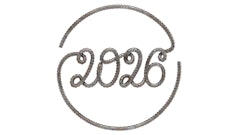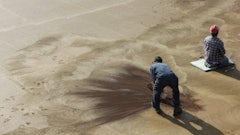Concrete mix
Generally speaking, the more cement in the mix, the stronger the reaction you will get from chemical stains, producing more intense colors. Therefore, use straight cement mixes, such as a five- or six-sack mix or higher, when possible. But be consistent: Staining an area of five-sack mix concrete that adjoins or butts up to an area made with a six-sack mix could cause color variations, despite the use of the same stain color.
Pozzolans and some cement replacements (such as fly ash and granulated blast-furnace slag) can have positive effects on concrete by improving finishability, reducing permeability, reducing efflorescence and minimizing color bleeding. But they also can lessen the reaction between the chemical stain and the concrete surface because removing a percentage of the cement reduces the amount of calcium hydroxide (a reaction product of hydrated lime). Metallic salts in chemical stains react with the calcium hydroxide to produce color.
Concrete admixtures
Most water reducers or air-entraining admixtures will not have a dramatic effect on the final stain appearance. Calcium-chloride-based accelerating admixtures, however, will have a visual impact, typically resulting in dark, splotchy areas. If it is necessary when pouring concrete in cooler weather to accelerate the setting time, consider using a nonchloride accelerator or hot water.
Aggregates used in concrete mix
While most contractors cannot influence the type of aggregate used in ready-mixed concrete, be aware that some lime-based aggregates, especially if close to the surface, can actually absorb stain and darken the color of the cement paste above the underlying aggregates. Also, certain types of aggregates found in the United States are not as absorbent and will not readily accept the stain.
It is good practice to routinely test the absorbency of the concrete substrate by wetting the surface with water prior to chemical stain application. In many cases, this simple test can help you determine if absorbent aggregates are too close to the surface. If you begin chemical staining before making this determination, it is generally too late. If you find that the surface is not a presentable enough canvas for your staining application, you may need to skim or overlay the concrete and then stain it.
Concrete finishing methods
The optimum finish, and my personal preference because I like the way the stain looks on it, is a hard-troweled surface. Although open finishes achieved with minimal troweling (such as a broom or float finish) tend to take more stain and produce more intense colors than hard-troweled surfaces, they are less dense, wear faster and lose color sooner.On slabs that have been power troweled to the point of the surface being “blackened,” the surface may need to be opened up by sanding, diamond grinding, or in extreme cases, a diluted acid wash.
Use the same finish from pour to pour if possible. Different textural finishes will give you different final stain effects. Also, finish the concrete with hand tools around floor outlets, plumbing risers, electrical sleeves and other obstructions so these areas are consistent in finish with the rest of the slab.
Concrete curing
Spray-applied liquid curing compounds should not be used because they produce residual buildup, which impedes stain penetration. Instead, use unwrinkled, nonstaining curing paper. If water curing has been specified, understand that this procedure could trap moisture in the slab. A high moisture content can affect the performance of sealer and topcoats.
Remember, there are many different factors that affect how a chemical stain takes to a concrete surface. Don’t cut corners to try and save time. Do the necessary upfront work so you can minimize any unforeseen surprises on your stain projects.
Bob Harris is the founder and president of the Decorative Concrete Institute in Douglasville, Ga., which provides hands-on training seminars in architectural concrete. He has personally placed or supervised the placement of more than 3 million sq. ft. of decorative concrete and has authored two best-selling books, Bob Harris’ Guide to Stained Concrete Interior Floors and Bob Harris’ Guide to Stamped Concrete. He can be reached at (877) DCI-8080.
















